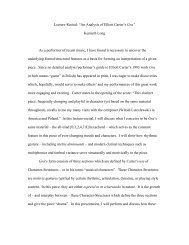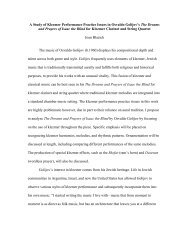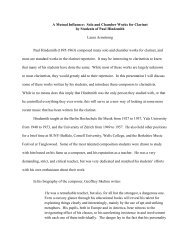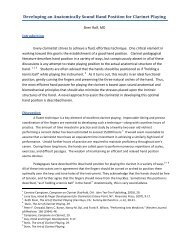Buffet Crampon's - International Clarinet Association
Buffet Crampon's - International Clarinet Association
Buffet Crampon's - International Clarinet Association
You also want an ePaper? Increase the reach of your titles
YUMPU automatically turns print PDFs into web optimized ePapers that Google loves.
and so on. This allows an easy analysis of<br />
secondary dominants by naming the original<br />
scale step and its chromatic alteration<br />
(e.g. I 7♭7 or VI 7 1). But this manner of naming<br />
secondary dominants has fallen out of<br />
favor, and one is now likely to see the II 7♯ 4<br />
described as V 7 of V.<br />
An early indoctrination in tonal thinking<br />
that I haven’t actually mentioned in a<br />
previous article is contained in Example 2.<br />
The three versions show how V, VII and<br />
V 7 sound very similar and all function as<br />
first classification chords leading directly<br />
to I (the tonic).<br />
Example 3 reviews the transposition<br />
procedure for all of the examples that follow.<br />
Supply the following key signatures<br />
to line 3A to achieve the first four varieties<br />
of seventh chord: 4 sharps = EM 7 , 3 sharps<br />
= EMm 7 , 1 sharp = Em 7 , 1 flat = Edm 7 .<br />
Diminished seventh chords are addressed<br />
in Example 14.<br />
Do not neglect the VII chord! How often have you or your students mistakenly turned a<br />
VII chord into a V 7 because the fingers, with a mind of their own, automatically fell into the<br />
V 7 , which has been drilled to the detriment of the poor, neglected VII triad? The routine in<br />
Example 2 will help prevent that problem, and should, of course, be done in all major and<br />
minor keys.<br />
The advanced intermediate student is now ready to learn all of the seventh chords in a<br />
three-octave range. The following exercises use the same procedures described in “Beyond<br />
Baermann” (The <strong>Clarinet</strong>, Vol. 32, No. 2, March 2005), “Mining for Minors” (June 2005),<br />
“Promise Her Anything but Give Her Arpeggios” (Sept. 2005), and “Etuduets” (Dec. 2005).<br />
In order to cover a lot of ground in this article, I will keep explanations at a minimum and<br />
ask you to consult the previous articles for details.<br />
Transpose 3A up to achieve the same<br />
four seventh chords with roots on F, F ♯ ,<br />
and G ♭ . Use 3B for G, G ♯ , and A ♭ : Use 3C<br />
for A, B ♭ and B: use 3D only for Adm7<br />
because it has E ♭ . This requires high G for<br />
the first time, and the best fingering to use<br />
is LH index finger with RH fork and E ♭<br />
key. The fork is prepared the same as it<br />
was for F ♯ , by curving the finger close to<br />
the rod so that it doesn’t hit the rings when<br />
they rise upon leaving E ♭ . This is an<br />
overblown “B”, so voicing of the tongue<br />
and throat is required but it is surprisingly<br />
easy because the feel is so similar to F#,<br />
which the student has already mastered.<br />
Use Example 3E for CM 7 , CMm 7 , C ♯ , D ♭ ,<br />
D, and E ♭ (another high G required). Example<br />
3F is for Cm 7 and Cdm 7 because<br />
they have E ♭ .<br />
March 2006 Page 9

















